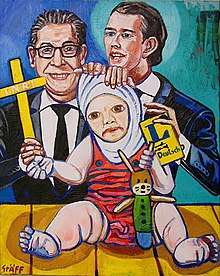Hijabophobia
Hijabophobia is a type of ethno-religious discrimination against Muslim women.[1]

Analysis
Hijabophobia is a term referring to discrimination against women wearing Islamic veils, including the hijab, niqāb and burqa. It is considered a gender-specific type of Islamophobia,[2][3][1] or simply "hostility towards the hijab".[4] In academic circles, the term is applied to discourse based in colonial representations of Muslim women as victims oppressed by misogynistic cultures. This leads to a "double phobia" which can affect scholars and policy-makers in their approaches to the veil debate.[1]
According to the The Gazette, hijabophobia began as a French national phenomenon, citing the 1989 headscarf affair (French: l'affaire du foulard).[5] In France, according to Ayhan Kaya, Islamophobia is mixed with hijabophobia.[6]
Political scientist Vincent Geisser argues that hijabophobia became more widespread after the September 11 attacks, as evidenced by the number of laws regulating and restricting hijab in public places and governmental offices.[7] A study found that Muslim girls in London perceived discrimination when wearing hijab outside their immediate communities, and felt social pressure to not wear hijab.[8]
Manifestations
Working places
European Court of Justice
A ruling by European Union's top law court, European Court of Justice, on 14 March 2017[lower-alpha 1] allowed the employers "to ban staff from wearing visible religious symbols"[9] such as hijab. The decision was criticized for disguising what Muslims described as "a direct attack on women wearing hijabs at work". As a result, by 2017, two women from France and Belgium were dismissed from work since they refused to remove their hijabs. Samira Achbita, a woman from Belgium, was dismissed from working in her company (G4S) as a result of the court ruling.[9] HuffingtonPost argued that the ruling was ostensibly based on the employer's wish "to portray a position of neutrality", and hence the court ruling was a normalization of hijabophobia.[4] Al-Jazeera described the ruling as setting precedent for a "de facto prevention" of employment for Muslim women wearing the hijab.[10]
Public places
There are instances where Muslim dress have been banned in public spaces. The Muslim burqa was banned by local laws in Spain in 2010, though these laws began to be overturned by the Spanish Supreme Court in 2013.[11] Similarly, in 2016, France's highest court began to overrule a ban on the burkini by over thirty French municipalities as Islamophobic.[12] FIFA's ban of the head cover in 2011–2014 is an example of hijabophobia.[2] In 2018, Austria banned full-face coverings in order to limit the visibility of orthodox Islam. This was criticized by police who were put in the position of charging people for wearing smog and ski masks. France and Belgium have enacted a similar ban since 2011. In 2015, a partial ban was introduced in the Netherlands and the German parliament banned face coverings while driving in September 2017.[13]
See also
Notes
- ↑ The court verdict: "the prohibition on wearing an Islamic headscarf, which arises from an internal rule of a private undertaking prohibiting the visible wearing of any political, philosophical or religious sign in the workplace, does not constitute direct discrimination based on religion or belief within the meaning of that directive."
References
- 1 2 3 Hamzeh, Manal (2012). Pedagogies of Deveiling: Muslim Girls and the Hijab Discourse. IAP. ISBN 9781617357244. Retrieved 4 September 2018.
- 1 2 Manal, Hamzaeh (1 July 2017). "FIFA's double hijabophobia: A colonialist and Islamist alliance racializing Muslim women soccer players". Women's Studies International Forum. 63: 11–16. ISSN 0277-5395. Retrieved 3 September 2018.
- ↑ MOHAMED-SALIH, Veronica. "Stereotypes regarding Muslim men and Muslim women on the Romanian Internet: a qualitative comparative analysis for 2004-2009 and 2010-2015" (PDF). Journal of Gender and Feminist Studies (4). Retrieved 4 September 2018.
- 1 2 Shebaya, Halim (2017-03-15). "The European Court Has Normalized Hijabophobia". Huffington Post. Retrieved 2018-09-04.
- ↑ Proceedings of the Fourth and Fifth Annual Symposia of the Institute of Islamic and Arabic Sciences in America. IIASA. 1999. ISBN 9781569230220. Retrieved 5 September 2018.
- ↑ Kaya, Ayhan (2012). Islam, Migration and Integration: The Age of Securitization. Palgrave Macmillan. ISBN 9781137030221. Retrieved 5 September 2018.
- ↑ Cesari, Jocelyne (2014). The Oxford Handbook of European Islam. Oxford University Press. ISBN 9780199607976.
- ↑ Keddie, Amanda (2017). Supporting and Educating Young Muslim Women: Stories from Australia and the UK. Taylor & Francis. ISBN 9781317308539. Retrieved 4 September 2018.
- 1 2 "Employers allowed to ban the hijab: EU court". www.aljazeera.com. Retrieved 2018-10-12.
Employers are entitled to ban staff from wearing visible religious symbols, the European Union's top law court ruled on Tuesday, a decision Muslims said was a direct attack on women wearing hijabs at work.
- ↑ Janmohamed, Shelina. "Hijab at work: EU court is authorising discrimination". www.aljazeera.com. Retrieved 12 October 2018.
- ↑ Ferschtman, Maxim; de la Serna, Cristina (22 March 2013). "Case Watch: Spanish Supreme Court Repeals City Burqa Ban". Case Watch. Open Society Foundations. Retrieved 13 October 2018.
- ↑ Bittermann, Jim; McKenzie, sheena; Shoichet, Catherine E. (26 August 2016). "French court suspends burkini ban". CNN. Turner Broadcasting System, Inc. Retrieved 13 October 2018.
- ↑ Oltermann, Philip (27 March 2018). "Austrian full-face veil ban condemned as a failure by police". The Guardian. Retrieved 10 September 2018.